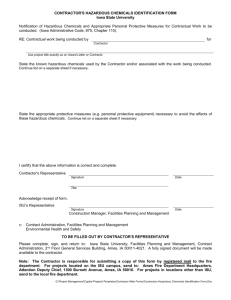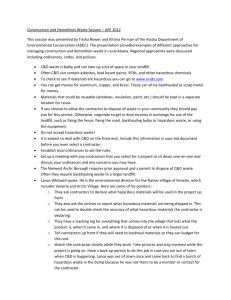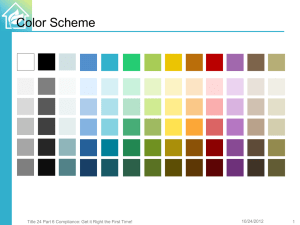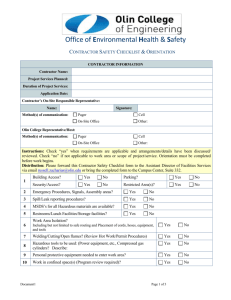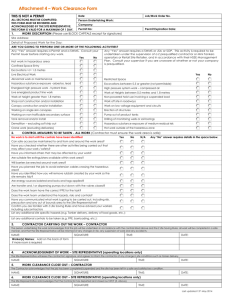Waste Management Plan Form - Energy Technology Assistance
advertisement
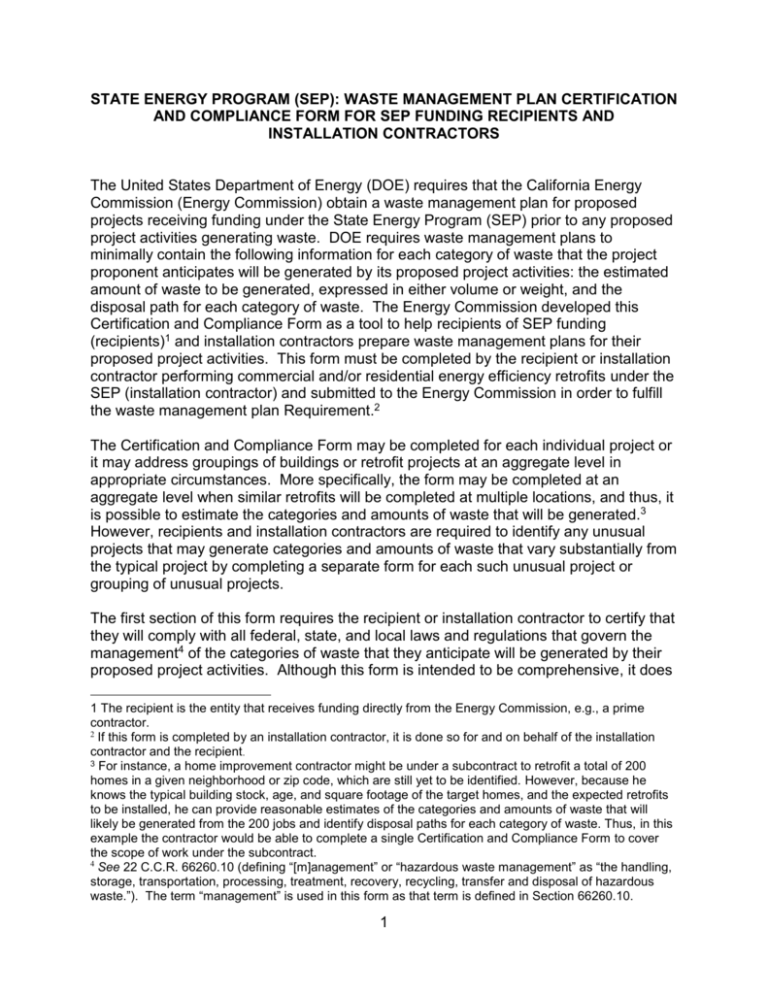
STATE ENERGY PROGRAM (SEP): WASTE MANAGEMENT PLAN CERTIFICATION AND COMPLIANCE FORM FOR SEP FUNDING RECIPIENTS AND INSTALLATION CONTRACTORS The United States Department of Energy (DOE) requires that the California Energy Commission (Energy Commission) obtain a waste management plan for proposed projects receiving funding under the State Energy Program (SEP) prior to any proposed project activities generating waste. DOE requires waste management plans to minimally contain the following information for each category of waste that the project proponent anticipates will be generated by its proposed project activities: the estimated amount of waste to be generated, expressed in either volume or weight, and the disposal path for each category of waste. The Energy Commission developed this Certification and Compliance Form as a tool to help recipients of SEP funding (recipients)1 and installation contractors prepare waste management plans for their proposed project activities. This form must be completed by the recipient or installation contractor performing commercial and/or residential energy efficiency retrofits under the SEP (installation contractor) and submitted to the Energy Commission in order to fulfill the waste management plan Requirement.2 The Certification and Compliance Form may be completed for each individual project or it may address groupings of buildings or retrofit projects at an aggregate level in appropriate circumstances. More specifically, the form may be completed at an aggregate level when similar retrofits will be completed at multiple locations, and thus, it is possible to estimate the categories and amounts of waste that will be generated.3 However, recipients and installation contractors are required to identify any unusual projects that may generate categories and amounts of waste that vary substantially from the typical project by completing a separate form for each such unusual project or grouping of unusual projects. The first section of this form requires the recipient or installation contractor to certify that they will comply with all federal, state, and local laws and regulations that govern the management4 of the categories of waste that they anticipate will be generated by their proposed project activities. Although this form is intended to be comprehensive, it does 1 The recipient is the entity that receives funding directly from the Energy Commission, e.g., a prime contractor. 2 If this form is completed by an installation contractor, it is done so for and on behalf of the installation contractor and the recipient. 3 For instance, a home improvement contractor might be under a subcontract to retrofit a total of 200 homes in a given neighborhood or zip code, which are still yet to be identified. However, because he knows the typical building stock, age, and square footage of the target homes, and the expected retrofits to be installed, he can provide reasonable estimates of the categories and amounts of waste that will likely be generated from the 200 jobs and identify disposal paths for each category of waste. Thus, in this example the contractor would be able to complete a single Certification and Compliance Form to cover the scope of work under the subcontract. 4 See 22 C.C.R. 66260.10 (defining “[m]anagement” or “hazardous waste management” as “the handling, storage, transportation, processing, treatment, recovery, recycling, transfer and disposal of hazardous waste.”). The term “management” is used in this form as that term is defined in Section 66260.10. 1 not necessarily include all of the waste management requirements that may apply to an individual project or any particular category of waste. Recipients and installation contractors are responsible for ensuring that they are in compliance with all federal, state, and local laws and regulations governing the management of wastes generated by their project activities under the SEP, including compliance with laws and regulations that are not referenced in this form. The second section of this form requires the recipient or installation contractor to describe their proposed project activities and requires the recipient or installation contractor to provide the following information for each category of waste that is expected to be generated: the estimated amount of waste to be generated, expressed in either volume or weight, and the disposal path for each category of waste. This form is intended to be used in conjunction with the accompanying guidance document titled, “State Energy Program (SEP): Guidance on Waste Management Plans for SEP Funding Recipients and Installation Contractors.” 2 CERTIFICATION OF COMPLIANCE A. GENERATION OF WASTE: 1. Do you anticipate that the proposed project(s), as described herein and funded under the SEP (project), will generate waste? Yes. (Recipients that expect to generate waste must answer all questions on this form and certify that all applicable requirements will be followed by signing this form and submitting it to the Energy Commission or recipients must direct their installation contractor to complete, sign, and submit this form on the recipient’s behalf.) No. I certify that the project will not generate any waste. (Please continue to the signature block on the bottom of this form, sign, and submit to the Energy Commission.) B. REQUIREMENTS FOR GENERATORS5 OF HAZARDOUS WASTE: 2. Do you anticipate that the project will generate wastes classified as hazardous wastes under the Resource Conservation and Recovery Act (RCRA)6? Yes. I certify that the recipient and installation contractor will comply with all applicable requirements for hazardous waste generators under federal, state, and local law, including, but not limited to, preparation of hazard waste manifests and record keeping, reporting, packaging, and labeling requirements. Please provide a hazardous waste identification number(s) issued by the United States Environmental Protection Agency (U.S. EPA ID Number) for each business address where such waste will be generated.78 U.S. EPA ID Number(s): 22 C.C.R. § 66260.10 (defining “generator” as “any person, by site, whose act or process produces hazardous waste identified or listed in chapter 11 of [Title 22 California Code of Regulations, Division 4.5] or whose act first causes a hazardous waste to become subject to regulation.”). The term “generator” is used in this form as that term is defined in Section 66260.10. 6 42 U.S.C. § 6901 et seq. (1976). 7 It is not necessary to obtain an EPA ID Number to dispose of universal waste, such as fluorescent lamps, if you will not accumulate more than 5,000 kilograms (11,000 lbs. or 5.5 tons) at any time. However, you must still comply with the universal waste regulations found in California Code of Regulations Sections 66273.30 through 66273.39. Similarly, it is not necessary to obtain an EPA ID Number to dispose of large appliances, such as air conditioners. However, specific materials, such as refrigerants, must be disposed of in accordance with the Certified Appliance Recycler laws found in Public Resources Code Section 42160 et seq. and Health and Safety Code Section 25211, et seq. 8 If the recipient and/or installation contractor is preparing the Waste Management Plan Certification and Compliance Form at an aggregate level, then it is not necessary to provide U.S. or California EPA I.D. Number(s), as appropriate, on this form. However, if the recipient and/or installation contractor does not provide EPA I.D. Number(s) on this form, then it must state how it will ensure that all required EPA I.D. Numbers are obtained prior to its project activities generating waste. 5 3 Note: If you anticipate generating RCRA hazardous waste and California only hazardous waste, you need only obtain a U.S. EPA ID Number(s). No (please continue to question 3) 3. Do you expect that the project will generate “California only” hazardous waste, such as asbestos? Yes. I certify that the recipient and installation contractor will comply with all applicable requirements for hazardous waste generators under federal, state, and local law, including, but not limited to, preparation of hazard waste manifests and record keeping, reporting, packaging, and labeling requirements. Please provide a California EPA ID Number(s) issued by the California Environmental Protection Agency (Cal/EPA), Department of Toxic Substances Control (DTSC) for each business address where such waste will be generated. California EPA ID Number(s): No. C. SPECIFIC HAZARDOUS WASTES: 4. Asbestos: Do you anticipate that the project will generate asbestos waste considered hazardous waste under California law? Yes. I certify that the recipient and installation contractor will comply with all applicable federal, state and local laws and regulations governing the management of asbestos hazardous waste, including, but not limited to, regulations governing atmospheric emissions of asbestos under the Federal National Emission Standard for Hazardous Air Pollutants (NESHAP),9 requirements governing the handling and disposal of asbestos waste under the Toxic Substances Control Act of 1976 (TSCA),10 and any additional packaging or notification requirements imposed by the governing local air pollution control district or air quality management district. I further certify that the recipient and installation contractor will dispose of all hazardous asbestos waste in a landfill authorized to accept asbestos waste by the governing Regional Water Quality Control Board. 9 See 40 C.F.R. §§ 61.140-61.157. 15 U.S.C. § 2601 et seq. (1976). 10 4 No. 5. Fluorescent Light Ballasts Containing PCBs: Do you anticipate that the project will generate fluorescent light ballasts containing polychlorinated biphenyls (PCBs) as waste? Yes. I certify that the recipient and installation contractor will comply with all applicable federal, state, and local laws and regulations — including any applicable exemptions — governing the management of these PCB wastes, including, but not limited to, disposal options for fluorescent light ballasts specified in TSCA, and general requirements for the management of hazardous waste provided in Title 22, California Code of Regulations, Division 4. No. 6. Caulk Containing PCBs: Do you anticipate that the project will generate caulk containing PCBs at levels of 50 parts per million or greater as waste? Yes. I certify that the recipient and installation contractor will comply with all applicable federal, state, and local laws and regulations governing the management of these PCB wastes, including, but not limited to, TSCA, and general requirements for the management of hazardous waste provided in Title 22, California Code of Regulations, Division 4.5. No. 7. Universal Waste: Do you anticipate that the project will generate universal waste, as defined under California law,11 such as fluorescent tubes or bulbs? Yes. I certify that the recipient and installation contractor will comply with all applicable federal, state, and local laws and regulations that specify requirements for the management of universal waste, including, but not limited to, personnel training, notification, reporting, recordkeeping, labeling and accumulation requirements. I further certify that the recipient and installation contractor will not use drumtop crushers designed to break mercury lamps into drums.12 11 22 C.C.R. § 66261.9 (identifying the following seven categories: electronic devices, batteries, electric lamps, mercury-containing equipment, cathode ray tubes (CRTs), CRT glass, non-empty aerosol cans). 12 See Mercury Lamp Disposal, Collection and Recycling, The Dangers of Drumtop Crushers, Department of Toxic Substances Control, California Environmental Protection Agency, available at http://ccelearn.csus.edu/mercurylamp/content/intro3.htm (on the website DTSC strongly cautions against the use of drumtop crushers designed to break mercury lamps into drums, stating “[t]o avoid exposing people to mercury poisoning and paying serious fines and penalties, do not use mercury lamp crushers in California.”). 5 No. 8. Recycling Materials that Require Special Handling from Major Appliances: Do you anticipate that the project will generate major appliances13 that contain materials which require special handling as waste? Yes. I certify that the recipient and installation contractor will comply with all applicable federal, state, and local laws and regulations that specify requirements for the recycling of materials contained in major appliances that require special handling, including, but not limited to, Title 40 of the Federal Code of Regulations Section 82.161 and the California Certified Appliance Recycler laws.14 No. 9. Other Hazardous Wastes: Do you anticipate that the project will generate RCRA and/or California only hazardous wastes not identified on this form? Yes, I certify that the recipient and installation contractor will comply with all applicable federal, state, and local laws and regulations that govern the management of the hazardous wastes identified below in response to this question. If yes, please identify these additional hazardous wastes: No D. CERTIFICATION REGARDING WORKING WITH CERTIFIED UNIFIED PROGRAM AGENCIES (CUPAs) (All recipients and installation contractors generating waste must certify to the following statement by checking the box below): I certify that the recipient and installation contractor will comply with all applicable business reporting and other requirements enforced by the governing local Certified Unified Program Agency (CUPA) or other participating agency for all waste that will be generated by the proposed project activities. See Cal. Pub. Res. Code § 42166 (defining “major appliance” as “any domestic or commercial device, including, but not limited to, a washing machine, clothes dryer, hot water heater, dehumidifier, conventional oven, microwave oven, stove, refrigerator, freezer, air-conditioner, trash compactor, and residential furnace”). 14 As noted, the Certified Appliance Recycler laws are found in California Public Resources Code Section 42160 et seq., and Health and Safety Code Section 25211, et seq. 13 6 E. CERTIFICATION REGARDING RECYCLING REQUIREMENTS UNDER CALIFORNIA LAW: (All recipients and installation contractors generating waste must certify to the following statement by checking the box below): I certify that the recipient and installation contractor will comply with all applicable recycling requirements established by the governing local jurisdiction for all waste that will be generated by the proposed project activities. 7 PROJECT DESCRIPTION AND ESTIMATED WASTE GENERATION AND DISPOSAL PATHS F. PROJECT DESCRIPTION: 10. Residential Retrofits: If the project activities involve energy efficiency retrofits to residential property please answer the following questions. Project zip code(s), if known: Number of homes or units: Single family or multifamily: Type(s) of energy efficiency retrofit(s): 11. Commercial Retrofits: If the project activities involve energy efficiency retrofits to commercial property please answer the following questions. Project address(es) (i.e., street, city, zipcode), if known: Type(s) of energy efficiency retrofit(s): G. ESTIMATED WASTE GENERATION AND DISPOSAL PATH(S): 12. Using the following table, identify each category and estimated amount of waste that the recipient and/or installation contractor anticipates will be generated by the project activities, expressed in either volume or weight, and the corresponding disposal path. Category of Waste Sample: Fluorescent bulbs Sample: HVAC (Major appliance containing Materials Requiring Special Handling (MRSH)) Estimated Volume or Weight of Waste that is Expected to be Generated by Project Activities Disposal Path for Each Category of Waste (it is not necessary to specify a particular disposal company or recycler) 100kg of T8 fluorescent bulbs (approximately 100 T8s) Bulbs will be handled and stored onsite. Bulbs will be labeled properly so that they are clearly identified as “Universal Waste Lamps” with the accumulation start date on the label. Installation contractor’s employees will be trained on the proper waste management of fluorescent bulbs. The bulbs will be shipped to a hazardous waste recycling facility within one year. Weight of appliance, e.g., 530 lbs Transport, deliver or sell unprocessed appliance to a Certified Appliance Recycler (CAR) 8 If more space is needed, please attach additional page(s) and check this box: The Energy Commission may request additional information in order to clarify answers provided on this form. If this Waste Management Plan Certification and Compliance Form is completed by the recipient, please provide the following information: Recipient’s Authorized Representative (print or type name): Title: Phone Number: Email: Signature: ___________________________________________________________ Date: If this Waste Management Plan Certification and Compliance Form is completed by the installation contractor for and on behalf of itself and the recipient, please provide the following information: Recipient Name: Energy Commission Agreement Number: Installation Contractor Name: Installation Contractor Address: Installation Contractor’s Authorized Representative (print or type name): Title: Phone Number: Email: Signature: ___________________________________________________________ Date: 9
